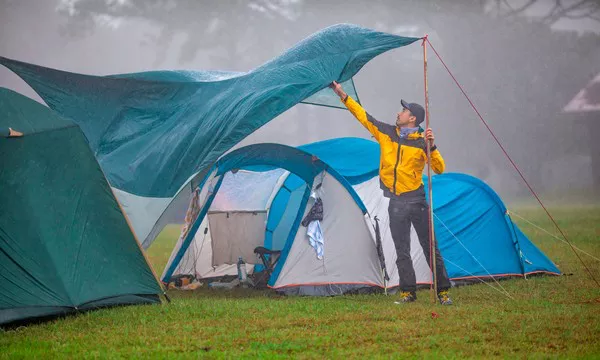When it comes to selecting the ideal tent for your outdoor adventure, one of the critical factors to consider is its waterproof rating. Amidst the myriad of options available, understanding what a 2000mm tent entails in terms of waterproofness is paramount. In this comprehensive guide, we delve into the nuances of tent waterproof ratings, demystify the significance of “mm,” explore the hydrostatic head test, analyze the suitability of different rating levels for various weather conditions, and scrutinize the capabilities and limitations of a 2000mm tent. Additionally, we offer insightful comparisons with tents boasting higher or lower ratings and provide tailored recommendations for diverse camping scenarios.
Explaining Waterproof Ratings: Deciphering the “mm”
Before delving into the specifics of a 2000mm tent, it’s essential to grasp the fundamentals of waterproof ratings. The “mm” in tent waterproofness refers to millimeters, indicating the measure of water pressure a fabric can withstand before it begins to leak. This measurement is determined through a standardized test known as the hydrostatic head test.
Understanding the Hydrostatic Head Test
The hydrostatic head test evaluates a fabric’s ability to resist water penetration under pressure. During the test, a column of water is gradually applied to the fabric until water seepage occurs. The height of the water column, measured in millimeters, at the point of leakage determines the fabric’s waterproof rating. A higher rating indicates greater water resistance.
Deciphering Rating Levels: Matching Weather Conditions
Waterproof ratings typically range from 500mm to 10,000mm or higher, with each level suited for different weather conditions:
- 500mm to 1000mm: Suitable for light rain and occasional showers. Ideal for mild weather conditions during summer camping trips.
- 1500mm to 2000mm: Adequate for moderate rainfall and extended exposure to damp conditions. Suitable for most camping adventures in typical weather conditions.
- 3000mm to 5000mm: Designed to withstand heavy rainfall and prolonged exposure to inclement weather. Recommended for camping in regions prone to frequent rain showers.
- 6000mm and above: Built for extreme weather conditions, including torrential downpours and harsh environments such as high-altitude mountaineering expeditions.
Examining the 2000mm Rating: What It Can Withstand
A tent with a 2000mm waterproof rating offers reliable protection against moderate rainfall and damp conditions. It is well-suited for camping trips in temperate climates where occasional showers are expected. However, it may struggle to withstand heavy downpours or prolonged exposure to continuous rain. While a 2000mm tent provides adequate waterproofing for most recreational camping scenarios, it may require additional precautions in challenging weather conditions.
Acknowledging Limitations: Challenges of a 2000mm Rating
Despite its versatility, a 2000mm tent has its limitations. In instances of heavy rainfall or prolonged exposure to wet weather, the tent’s waterproofing may become compromised, leading to moisture seepage. Additionally, factors such as wind speed, fabric quality, and tent design can influence the overall effectiveness of the waterproofing.
Comparative Analysis: 2000mm Tents vs. Alternatives
When comparing 2000mm tents to alternatives with higher or lower ratings, several factors come into play:
- Higher-rated tents (e.g., 3000mm or above) offer superior waterproofing, making them suitable for more challenging weather conditions. However, they may be bulkier and heavier, impacting portability.
- Lower-rated tents (e.g., 1000mm) are lightweight and compact, ideal for backpacking or casual camping in fair weather. However, they may not provide adequate protection in moderate to heavy rainfall.
Pros and Cons of Each Option
1. 2000mm Tents:
- Pros: Versatile, suitable for most camping scenarios, balances waterproofing with weight and portability.
- Cons: May struggle in heavy downpours or prolonged exposure to rain, requires additional precautions in adverse weather conditions.
2. Higher-rated Tents:
- Pros: Superior waterproofing, suitable for extreme weather conditions.
- Cons: Heavier and bulkier, less portable.
3. Lower-rated Tents:
- Pros: Lightweight and compact, ideal for backpacking or casual camping.
- Cons: Limited waterproofing, may not withstand moderate to heavy rainfall.
Tailored Recommendations for Different Camping Scenarios
- Casual Camping: A 2000mm tent offers sufficient waterproofing for weekend camping trips in typical weather conditions.
- Backpacking: Opt for a lightweight tent with a lower rating for enhanced portability, but be prepared for potential moisture issues during rain showers.
- Mountaineering: Choose a tent with a higher waterproof rating (5000mm or above) to withstand harsh weather conditions at higher altitudes.
Additional Waterproofing Measures for Extreme Conditions
In extreme weather conditions, such as heavy rainstorms or snowfall, it’s advisable to implement additional waterproofing measures:
- Seam sealing: Apply seam sealer to the tent seams to prevent water seepage.
- Groundsheet: Use a waterproof groundsheet or footprint to protect the tent floor from moisture.
- Rainfly: Ensure the rainfly is properly secured and extends beyond the tent body to provide maximum coverage.
Conclusion
In conclusion, while a 2000mm tent offers reliable waterproofing for most camping adventures, it’s essential to consider the specific weather conditions and terrain of your destination. By understanding the nuances of waterproof ratings, assessing the pros and cons of different options, and implementing additional waterproofing measures when necessary, you can ensure a comfortable and enjoyable outdoor experience, no matter the forecast.

